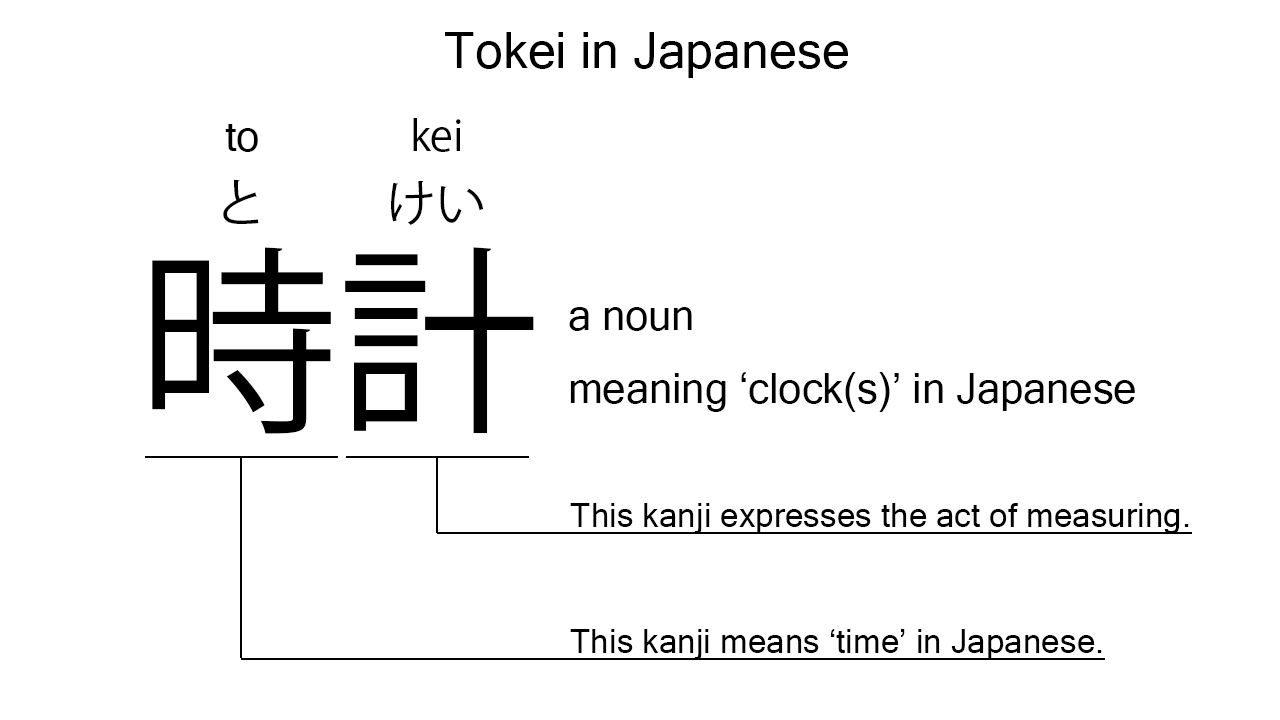What does “tokei” mean in Japanese?
Japanese native speakers say “tokei” to mean ‘clock’ in general. Perhaps, some Japanese learners know this word as it is sometimes used in Japanese conversations. In this blog post, however, I will explain this word in detail based on its kanji expression. And also, I will explain how to use it through example sentences. My explanations would help Japanese learners understand “tokei” more clearly. Then, let’s get started!
Contents
Definition and meanings of “tokei”
Let me start with the definition and meanings of “tokei”.
- tokei – 時計 (とけい) : a noun meaning ‘clock’ in Japanese. This can cover ‘watch’ as well. This can also work as plural. Learn more about Japanese plural.
Japanese native speakers use this noun to refer to objects which measure time in general.
The definition and meanings are simple and clear, I think. To understand this noun more clearly, however, let me explain its kanji characters in detail, one by one.
Tokei in kanji
The kanji expression of “tokei” consists of the following two kanji characters:
- 時 : a kanji character used to mean ‘time’ in Japanese.
- 計 : a kanji character used to express the act of measuring. This can also be found in other words like “keikaku“.
These two kanji characters tell us that “tokei” literally means ‘time measuring’ in Japanese. This kanji concept represents very well the objects which the noun refers to.

When we meet new kanji expressions, we should check their kanji characters in detail to understand their meanings clearly and deeply. In many cases, kanji characters tell us a lot about the meanings of the expressions they form. Actually, here, we could get the better understanding of “tokei” through the detailed kanji check above.
So far, I’ve explained the definition and meanings of “tokei” together with its kanji characters. Then, let me explain how to use it through the example sentences below.
Example #1: how to say “clock” in Japanese
kanojo wa atarashii tokei wo kat ta – 彼女は新しい時計を買った (かのじょはあたらしいとけいをかった)
She bought a new clock.
Below are the new words used in the example sentence.
- kanojo – 彼女 (かのじょ) : a pronoun meaning ‘she’ in Japanese.
- wa – は : a binding particle working as a case marker or topic marker. In the example, this works after “kanojo” to make the subject in the sentence.
- atarashii – 新しい (あたらしい) : an i-adjective meaning ‘new’ in Japanese.
- wo – を : a case particle used to make the object word in a sentence. In the example, this is used after “atarashii tokei” to make the object in the sentence.
- kat – 買っ (かっ) : one conjugation of the verb, “kau“, which means ‘to buy’ or ‘to purchase’ in Japanese. In the example, it has been conjugated for the better connection with its following word.
- ta – た : an auxiliary verb used after a verb, adjective, or auxiliary verb to make its past tense form. In the example, this is used after “kat” to make its past tense form, “kat ta”.
This is a typical usage of “tokei”. In the example, it works together with “atarashii” to say “a new clock” in Japanese.
Example #2: another usage of “tokei”
watashi wa tokei ga totemo suki desu – 私は時計がとても好きです (わたしはとけいがとてもすきです)
I love watches so much.
Below are the new words used in the example sentence.
- watashi – 私 (わたし) : a pronoun meaning ‘I’ in Japanese.
- ga – が : a case particle used to make the subject word or the object word in a sentence. In the example, this is used after “tokei” to make the object in the sentence.
- totemo – とても : an adverb of degree meaning ‘very’, ‘much’, ‘so’, or such in Japanese.
- suki – 好き (すき) : the stem part of the na-adjective, “sukina”, which means ‘favorite’ in Japanese. Native speakers, however, often use this as an individual word to mean ‘to like’ or ‘to love’. In the example, actually, this is used to mean ‘to love’ in Japanese.
- desu – です : an auxiliary verb used after a noun or adjective to make it polite. Perhaps, this is well known as a part of the Japanese desu form. In the example, this is used after “suki” to make it sound polite.
This is another typical usage of “tokei”. When we want to say “watches” in Japanese, this noun is a very good option.
Summary
In this blog post, I’ve explained the definition and meanings of “tokei” in detail based on its kanji expression. And also, I’ve explained how to use it through the example sentences. Let me summarize them as follows.
- tokei – 時計 (とけい) : a noun meaning ‘clock’ in Japanese. This noun can cover ‘watch’ as well. This can also work as plural. Japanese native speakers use this noun to refer to objects which measure time in general. These two kanji characters literally mean ‘time measuring’ in Japanese. This kanji concept represents very well the objects which this noun refers to.
Hope my explanations are understandable and helpful for Japanese learners.